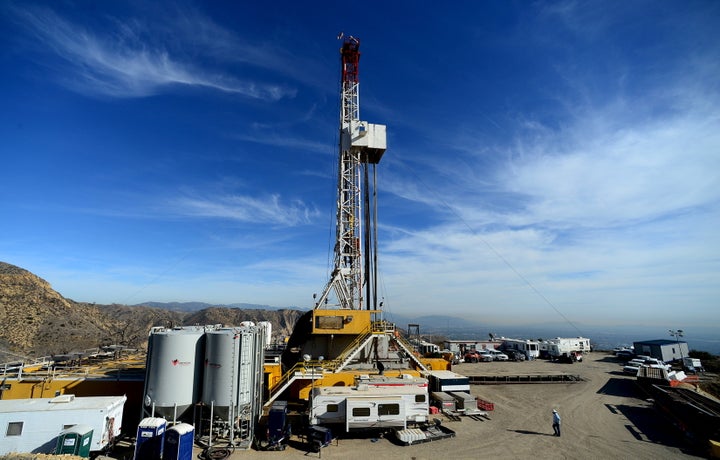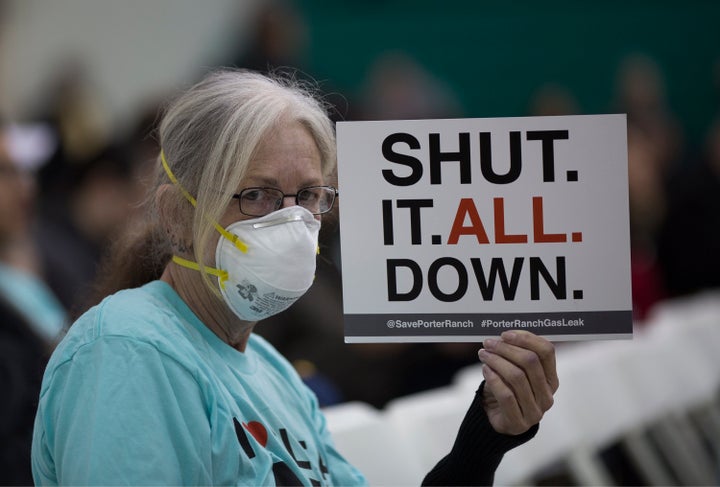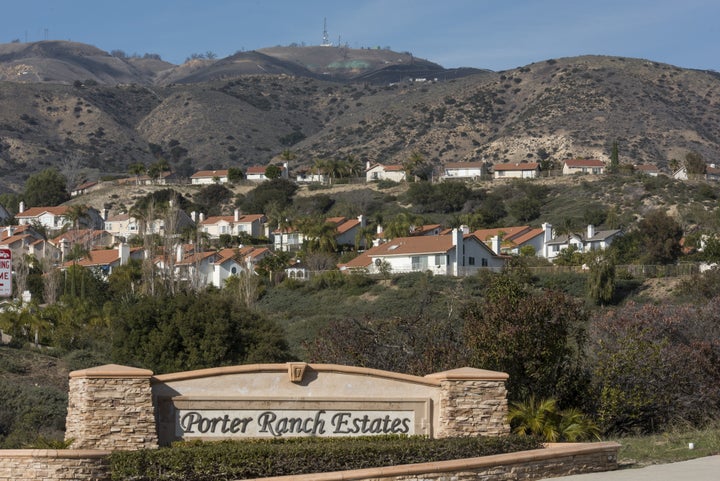
LOS ANGELES -- Call it a canary in a natural gas storage zone.
The enormous volume of natural gas spewing from a broken well here should serve as a wake-up call that more catastrophes are waiting to happen at similar facilities nationwide, conservationists warn.
Aging infrastructure, industry negligence and scant state regulations are all factors that led to the enormous Aliso Canyon methane leak now plaguing the affluent Porter Ranch community, and they are common problems across California and the nation, according to environmental experts.
Gas fields that are converted into natural gas storage areas are quite similar to each other, said Briana Mordick, a geologist and senior scientist for Natural Resources Defense Council: “They’re these antiquated fields with old wells in them, and there’s no reason to believe that any one of them have been operated in a way that’s so much better than Aliso Canyon."
"My fear is that when you actually take a hard look at these facilities, there’s going to be a lot to be worried about,” she added.
Disturbingly, smaller versions of the leak at the Aliso Canyon natural gas storage facility -- which has ejected nearly 90 thousand metric tons of methane into the air since October and has become California’s largest contributor to climate change -- are happening all the time.
“This is illustrative of a problem that is happening every day, even though it’s fair to say that Aliso Canyon is a uniquely large event,” said Mark Brownstein, the vice president of the Environmental Defense Fund’s climate and energy program. According to EDF studies at gas storage sites nationwide, consistent leaks and other accidents are regularly to blame for greenhouse gas emissions.
“A fair chunk of the emissions associated with the oil and gas industry in the U.S. come from these types of events: leaks on systems, equipment that fails, equipment that malfunctions. We’ve even seen examples where hatches to storage tanks are left open,” he said.
Gas leaking from the Aliso Canyon storage facility is invisible to the naked eye, but can be seen in this infrared video from Morgan & Morgan, one of many law firms involved in representing Porter Ranch residents in leak-related lawsuits.
The Aliso Canyon site, one of the largest of its kind, is one of 14 underground natural gas storage facilities in California. It was built in 1953, long before there was any standard for encasing wells in cement from top to bottom to prevent these kinds of accidents, LA Weekly reports.
Yet all of California's natural gas storage facilities are old and some have a history of disastrous leaks. “Obviously, Aliso Canyon is the biggest problem for the state, but there are documented problems at other storage facilities in California,” Mordick said. Aging equipment and a lack of detailed, consistent safety standards over time has a lot to do with those problems, she explained.
"[Gas companies] drill a well, they decide they don’t want to use it anymore so they plug it -- but if they plugged it 40, 50, 60 years ago, the standards are obviously very different," Mordick said. "Materials degrade over time, and there’s no one keeping an eye on them. So those leak. They leak through old abandoned well bores.”
The Southern California Gas Comany, which operates the Aliso Canyon storage facility, could have prevented the latest disaster by replacing a safety valve that stopped working in 1979. However, because California law only requires safety valves on wells within 100 feet of a road or a park or within 300 feet of a home, SoCalGas opted not to replace the hard-to-find piece.
Gas companies are under little obligation to keep the wells maintained, Mordick says.
“Statewide, there are no rules for well construction, for gas storage fields -- none,” she said. “California just took this seemingly hands-off approach; it’s up the operators to decide what they want to do. And of course, they are going to do the minimum thing that’s required.”
But that may be changing. Just last week, after California Gov. Jerry Brown (D) declared a state of emergency over the disaster, California's Division of Oil, Gas & Geothermal Resources announced emergency regulations for all of the state’s natural gas storage facilities. The regulations will address issues surrounding inspections, testing and the “need for operators to create risk management plans,” the agency says.
Previously, regulations governing “gas storage projects” in California consisted of less than 90 words in the state code. The new emergency rules specifically apply to “underground gas storage projects” and expand the regulations by about three and a half pages.
“The regulations are designed to ensure that there are no further events similar to the ongoing leak at Aliso Canyon,” said Don Drysdale, a spokesman for DOGGR, about the scope of the proposed regulations.
Barring any major changes, the rules will go into effect in early February.

While these new regulations are a good start for assessing the current safety of underground storage facilities statewide, Mordick says they “fall far short” of a full set of measures “needed to modernize both these facilities and the way they’re regulated.”
Linda Capato Jr., the fracking campaign coordinator for the environmental group 350.org, agrees that regulations should be “much tougher.”
“You look at things like the Santa Barbara oil spill that just happened, the oil spill that happened over the last few years in L.A., the things that are happening on a regular basis in places like Kern County and Porter Ranch -- these are all indicators of a failing regulatory system that can’t keep us safe from things that are inherently dangerous,” she said.
Since the Aliso Canyon leak sprung, about 87,000 metric tons of methane gas have billowed from the broken well, according to EDF, which estimates that the leak is likely responsible for one-quarter of California’s daily methane emissions.
Methane is a powerful greenhouse gas that carries 84 times the warming power of carbon dioxide for two decades after it's released, EDF reports. The group says the Aliso Canyon leak is likely the reason that methane emissions associated with natural gas doubled in the state last year.
The leak has about the same daily global warming potential as one large coal-fired power plant, said Christine Ehlig-Economides, a professor in the University of Houston's petroleum engineering department.
And while the environmental impact of the leak is already becoming alarmingly clear, the effects of a disaster like this on residents' health and livelihoods can’t always be immediately measured.
Methane gas itself isn’t toxic, but exposure to a gas mixed into methane called mercaptan, which gives it a distinctive rotten smell, can lead to short-term health issues, state regulators have said.
Thousands of residents near the leak are suffering from headaches, nosebleeds, coughs and other symptoms linked to methane exposure. They've been forced to relocate to hotels and temporary apartments.
Matt Pakucko, president and co-founder of Save Porter Ranch -- a neighborhood advocacy group that wants SoCalGas to shut down the storage site -- has moved to a hotel to seek refuge from sudden coughing, shoulder aches and pains and flu-like symptoms.
Locals are also worried about small businesses going under and their home values decreasing as a result of the leak.
Melissa Barrett, a Porter Ranch homeowner and single mother, said that aside from seeing her 12-year-old daughter get sick, the worst part of the disaster is having to worry about the value of her home declining -- a concern she’s already discussing with a lawyer.
She’s not the only one. There may be as many as 1,000 lawsuits pending from residents already.
While Pakucko's group focuses on advocating for Porter Ranch residents whose lives have been upended by the leak, he knows the environmental consequences of the leak aren’t confined to his community.
“This isn’t a Porter Ranch problem, it’s a global problem,” Pakucko said. “The gas doesn’t know borders.”

On Dec. 4, SoCalGas began drilling a relief well at the Aliso Canyon site as part of a plan to stop the blowout. The company said this week that the plan is ahead of schedule and that it expects the leak will be stopped by late February. Once the broken well is sealed, SoCalGas says it will be taken out of service permanently.
Yet California isn't the only state to face the threat of future leaks at gas storage facilities. There are more than 330 underground gas storage facilities across the nation, many of which still use vintage equipment and operate in states with lax regulations.
“It’s a problem at gas storage facilities across the U.S.,” Brownstein said. “I don’t want people to lose sight of the fact that while this is a big pollution event with huge impacts to the community, and [one that] certainly upends a lot of progress that California has been trying to make on climate change, it really is symptomatic of a larger, more systemic problem of the oil and gas industry.”
Mordick said that the history of gas leak disasters at underground storage facilities in California, long before Porter Ranch, should have attracted attention a long time ago. But that didn’t happen. And the leaks continued with regularity -- illustrating that we wait to react to the next gas storage disaster at our own peril.
“Until we take a hard look at how all these facilities across the U.S. are regulated and operated,” Mordick said, “there is reason to worry that a similar disaster could happen again.”
Read Part 1 of this story: Here’s What It’s Like To Live Next To California’s Gas Blowout Catastrophe.
Also on HuffPost:
